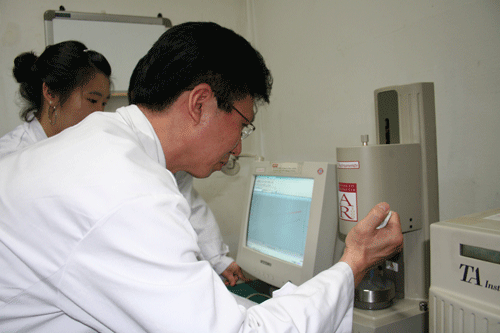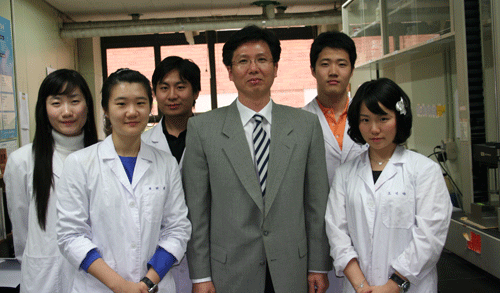동국학술대상 수상한 식품공학과 유병승 교수

그는 무엇이든지 세계화되는 오늘날 세계적인 학자가 되기 위해서는 국내에 치중하기 보다는 국제 학술지에 논문을 많이 내야 한다고 말한다. 그 역시 이 추세에 발맞춰 국제학술논문을 많이 썼는데, 외국 학술지에 논문을 낼 것을 염두에 두고 연구 주제를 잡는 등 6-7년 전부터 꾸준히 국제 학술지를 내기 위해 노력하고 있다.
그는 학생들에게도 국제 학술지를 내도록 유도하고 있다. 그가 지도하는 대학원생들은 최소 한 편 정도의 국제학술지(SCI)논문을 썼고 국내까지 합하면 졸업 때까지 평균 3편 정도를 쓰게 된다고 한다. 국제학술지는 국내학술지에 비해 실험이 어렵고 시간 투자가 많이 필요한 만큼 학생들에게 실험논문의 제목을 일찍 주어서 졸업 전까지 국제 학술지를 낼 수 있게끔 지도하고 있다.
가장 기억에 남는 논문이 무엇이냐는 질문에 그는 2001년에 쓴 고추장에 관련된 국제학술논문(SCI)인 ‘RHEOLOGICAL PROPERTIES OF HOT PEPPER-SOYBEAN PASTE(kochujang)’를 꼽았다. 이는 고추장이 이전에 미국에서 연구한 토마토 퓨레(puree)와 물성은 비슷하지만 발효식품이라는 데 착안한 것이다. 당시 국내저널에는 고추장에 대한 논문이 많았지만 국제학술지에는 우리나라 전통 식품인 고추장이 처음으로 등장한 것이라 의미가 있다.
그가 처음 학교에서 연구를 시작했을 당시만 해도 여건이 매우 열악했지만 학교에서 종종 지원을 받고 프로젝트를 하면서 하나씩 갖춰나가다 보니 지금은 시설이 상당히 좋은 편이다. 연구용 분석기자재의 경우 외국의 대학에 비교해도 뒤처지지 않을 정도이다. 다만 새로운 연구를 위해서는 새로운 기자재가 뒷받침 되어야 한다고.

뿐만 아니라 그는 불교에 관련된 식품연구를 병행하고 싶어서 얼마 전 불교가공식품 연구소 설립계획서를 냈다. 이는 우리학교의 건학 이념인 불교와도 들어맞는데, 사찰음식 중 가공할 수 있는 식품을 연구하고 싶다고.
힘든 연구를 소화해 내면서도 때때로 주위의 말 한 마디는 그에게 큰 힘이 된다. 그는 박사학위를 따기 위해 외국에서 공부중인 제자가 수업에서 자신의 논문을 가지고 공부하고 있어서 기분이 좋다고 연락을 해 왔을 때를 회상하며 흐뭇해했다. 또한 미국에 있을 당시 지도교수님이 외국의 학술지에 등장하는 유 교수의 이름을 보고 유 교수가 이 분야에서 열심히 연구하고 있다는 것을 안다고 말할 때 역시 보람된 순간이다.
유 교수는 학생들에게 전공분야에만 치중하지 말고 다양한 정보를 습득할 수 있는 여건을 만들어 폭넓은 학문을 익히고 넓은 시야를 가질 것을 당부했다. 이를테면 사회에서는 식품공학과 관련된 마케팅 개론이나 경영학 개론 등도 요구하기 때문에, 전공에 보탬이 되는 교양을 학창시절에 많이 접하는 것이 중요하다고 말한다. 또한 우리학교 학생들은 연구보다는 취업을 택하고 국내에 머무르는 경우가 많은데, 외국 대학에 가서 새로운 견문을 익히고 세계가 빨리 돌아가고 있음을 아는 것이 중요하다고.
더불어 새로운 총장님이 오시면서 모든 것이 많이 변했는데, 건학 101주년을 맞이해서 발전적인 방향으로 동국대가 한 단계 성장할 수 있는 계기가 되었으면 한다고 학교에 대한 애정을 드러냈다. “내 전공분야를 계속 살려서 식품 레올로지로 세계적으로 알려진 학자가 되는 것이 소망”이라는 유 교수. 지금처럼 열성적으로 연구에 임한다면 그 꿈은 머지않아 현실이 될 것이다.

